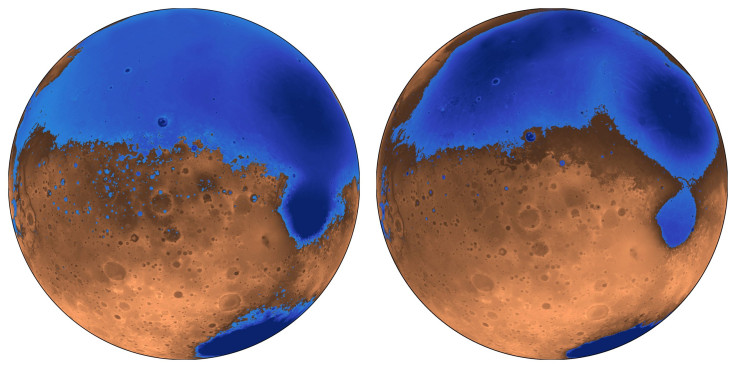Volcanoes On Mars Supported Ancient Oceans Which Were Shallower Than Previously Thought

We know now our cold and dry neighbor Mars once had liquid water on its surface, and it is thought large oceans once existed on the red planet too. A new theory agrees with that, but says the historic oceans formed earlier in time, were shallower than is currently thought, and were supported by the largest Martian volcano system.
Researchers from the University of California, Berkeley, proposed a new model Monday to explain the formation of Martian oceans. They said in their paper that contrary to current assumptions, “the oceans formed before or at the same time as Mars’ largest volcanic feature, Tharsis, instead of after Tharsis formed 3.7 billion years ago.”
“Volcanoes may be important in creating the conditions for Mars to be wet. … The assumption was that Tharsis formed quickly and early, rather than gradually, and that the oceans came later. We’re saying that the oceans predate and accompany the lava outpourings that made Tharsis,” Michael Manga, a professor at the university and coauthor of the paper, said in a statement Monday.
Manga explained the greenhouse effect caused by the accumulation of gases in the atmosphere, as a result of volcanic eruptions, would have kept Mars warm and therefore allowed liquid water to exist on its surface. In addition, the eruptions would have also created channels below the surface through which underground water could reach the surface and fill up what are today known as Mars’ northern plains.
There is also the matter of the irregular shoreline of the ancient oceans, often used as an argument against the existence of large water bodies in the past, since shorelines on Earth are level. The paper tries to explain that irregularity too, by suggesting Tharsis had a role in deforming the shoreline.
“This irregularity could be explained if the first ocean, called Arabia, started forming about 4 billion years ago and existed, if intermittently, during as much as the first 20 percent of Tharsis’s growth. The growing volcano would have depressed the land and deformed the shoreline over time, which could explain the irregular heights of the Arabia shoreline. Similarly, the irregular shoreline of a subsequent ocean, called Deuteronilus, could be explained if it formed during the last 17 percent of Tharsis’s growth, about 3.6 billion years ago,” the statement said.
“These shorelines could have been emplaced by a large body of liquid water that existed before and during the emplacement of Tharsis, instead of afterwards,” Robert Citron, a graduate student at the university and first author of the paper, said in the statement.
Tharsis is a volcanic complex about 5,000 kilometers wide, and is home to some of the largest volcanoes in the solar system. Its mass creates bulge on the planet’s opposite side and a depression in between, and that could explain the fact the topography of Martian northern plains today could hold about twice as much water as they could about 4 billion years ago.
This is important, because the large volume of water that could be held in the northern plains today is a lot more than what is frozen in the polar ice caps, and even including estimates of water below the Martian surface and that which escaped into space.
The paper appeared online in the journal Nature under the title “Timing of oceans on Mars from shoreline deformation.”
© Copyright IBTimes 2024. All rights reserved.





















